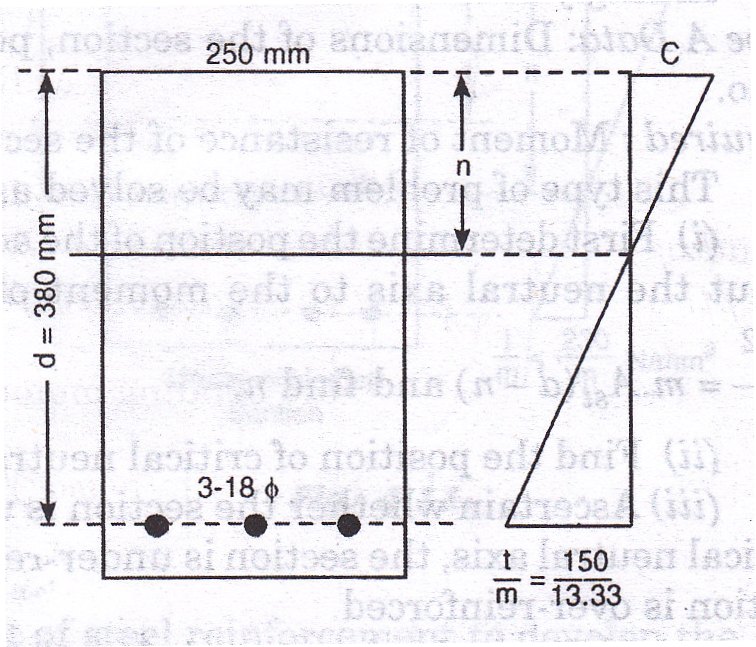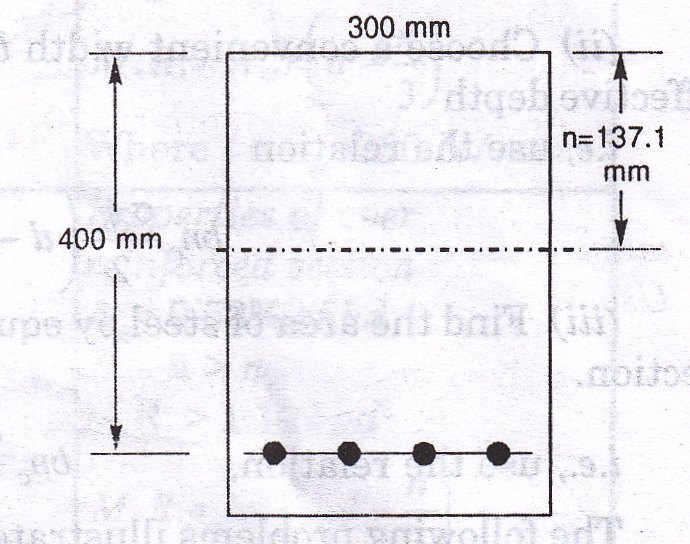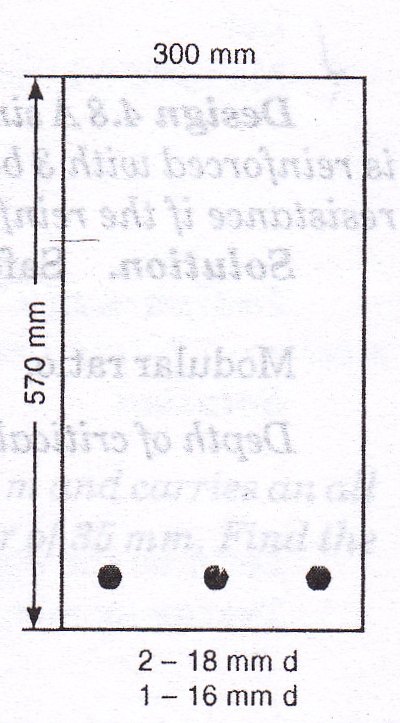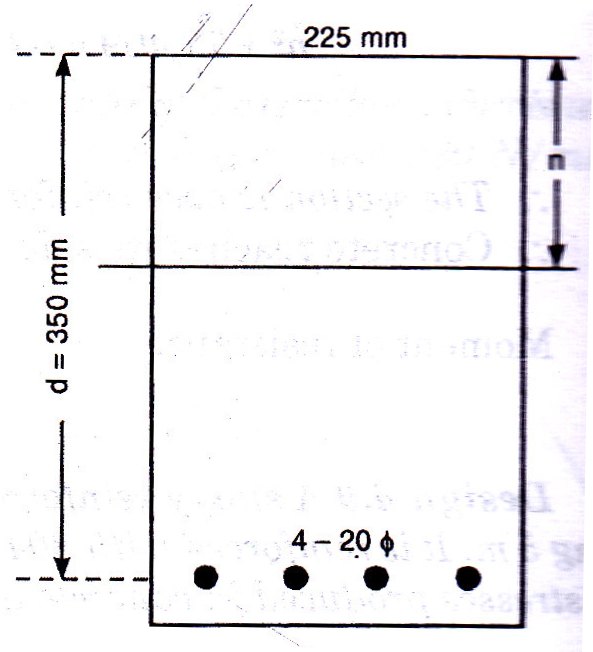Site pages
Current course
Participants
General
MODULE 1.
MODULE 2.
MODULE 3.
MODULE 4.
MODULE 5.
MODULE 6.
MODULE 7.
MODULE 8.
MODULE 9.
MODULE 10.
MODULE 11.
MODULE 12.
LESSON 17. Design of Singly Reinforced Section
17.1 INTRODUCTION
In singly-reinforced beams we come across the following types of problems:
Type A Data: Dimensions of the section, permissible stresses in concrete and steel, area of tensile steel and modular ratio.
Required: Moment of resistance of the section.
This type of problem may be solved as follows:
-
First determine the position of the actual neutral axis by equating the moment of the concrete area in compression about the neutral axis to the moment of equivalent tension area about the neutral axis i.e. use the relation,
-
Find the position of critical neutral axis corresponding to the given safe stresses in concrete and steel.
-
Ascertain whether the section is under-reinforced or over-reinforced. If the actual neutral axis lies above the critical neutral axis, the section is under-reinforced. But, if the actual neutral axis is below the critical neutral axis, the section is over-reinforced
-
If the section is over-reinforced concrete attains its permissible stress earlier than steel, and the moment of resistance is given by
Taking, c = = permissible stress in concrete
and n = depth of actual neutral axis.
If the section is under-reinforced, steel attains its permissible stress earlier than concrete and the moment of resistance is given by
M.R. =
taking, t = = permissible stress in steel
and n = depth of actual neutral axis.
Type B Data : Dimensions of the section, Area of reinforcement, Bending moment M and modular ratio.
Required : Stresses in concrete and steel.
This type of problem may be solved as follows:
1. Determine the position of the actual neutral axis.
2. Find the stress in concrete by equating the moment of resistance to the given bending moment i.e., use the relation,
3. Find the stress in steel from the relation.
Type C Data : Permissible stresses in concrete and steel, Bending moment M and modular ratio.
Required: To design the section.
This type of problem may be solved as follows: The beam will be designed as a balanced section
1.Determine the depth of critical neutral axis in terms of the effective depth d.
2. Choose a convenient width b. By equating the moment of resistance to the given bending moment, find the effective depth
3. Find the area of steel by equating the total compression on the beam section to the total tension on the beam section.
The following problems illustrate the above types of problems.
Example 17.1 A singly reinforced beam 250 mm wide and 380 mm deep to the centre of reinforced with 3 bars of 18 mm diameter. Determine the depth of neutral axis and the maximum stress in concrete when the stress in steel is 150 N/mm2. Take m = 13.33.
Solution.
Position of neutral axis (see Fig. 17.1)

Example 17.2 The cross-section of a singly-reinforced concrete beam is 300 mm wide and 400 mm deep to the centre of the reinforcement which consists of three bars of 12 mm diameters. If the stresses in concrete and steel are not to exceed 7 N/mm2 and 230 N/mm2, determine the moment of resistance of the section. Take m =13.33
Solution. Area of steel
Position of actual neutral axis (see Fig. 17.2)

Taking moments about the neutral axis,
Example 17.3 The cross-section of a singly-reinforced concrete beam is 300 mm wide and 400 mm deep to the centre of the reinforcement which consists of four bars of 16 mm diameter. If the stresses in concrete and steel are not exceed 7 N/mm2 respectively, determine the moment of resistance of the section. Take m = 13.33.
Solution.
Position of actual neutral axis (see Fig. 17.3)

Taking moments about the neutral axis
Example 17.4 A singly-reinforced rectangular beam 350 mm wide has a span of 6.25 m and carries an all inclusive load of 16.30 kN/m. If the stresses in concrete and steel shall not exceed 7 N/mm2 and 230 N/mm2 find the effective depth and the area of the tensile reinforcement. Take m=13.33.
Example 17.5 A singly reinforced beam has a span of 5 meters and carries a uniformly distributed load of 25 kN/m. The width of the beam is chosen to be 300 mm. Find the depth and the steel area requited for a balanced section. Use M 20 concrete and Fe415 steel
Solution Maximum bending moment M = = 78.125 kNm
The section is a balanced section (see Fig. 17.4).

Equating balanced M.R. to bending moment
0.913 bd2 = 0.913 x 300 d2 = 78.123 x 106
Therefore d = 534 mm
Area of steel required = = 706.7 mm2
Provide 2 bars of 18 mmΦ and 1 bar 16 mmΦ
Area of steel provided = 2 (254) + 201 = 709 mm2
Overall depth of the beam = 534 + 9 + 25 = 568 mm
Let us provide an overall depth of 570 mm
Actual effective depth = 570-34 = 536 mm
Example 17.6 Design a singly reinforced beam section subjected to a maximum bending moment of 55.35 kNm. The width of the beam may be made two third the effective depth. Use M 20 concrete and Fe415 steel.
Provide b = 300 mm, d = 450 mm
Provide 3 bars of 16 mm of (603 mm2)
Example 17.7 A singly-reinforced concrete beam is 300 mm wide and 450mm deep to the centre of the tensile reinforcement which consists of 4 bars of 16 mm diameter. If the safe stresses in concrete and steel are 7 N/mm2 and 230 N/mm2 respectively, find the moment of resistance of the section. Take m = 13.33.
Solution.
b = 300 mm, d =450 mm
= 4 x 201 = 804 mm2
Depth of actual Neutral axis
Therefore = 129.9 mm
Depth of actual Neutral axis,
Taking moments about the neutral axis,
Since n>nc the section is over reinforced
Therefore Concrete attains its safe stress earlier to steel.
Moment of resistance =
Example 17.8 A singly-reinforced concrete beam 350 mm wide and 550mm deep to the centre of the tensile reinforcement is reinforced with 3 bars of 18 mm diameter. Find the moment of resistance of the section. What would be the moment of resistance if the reinforcement is changed to 4 bars of 18 mm diameter. Use M 20 concrete and Fe 415 steel.
Solution. Safe stresses σcbc = 7 N/mm2, σst = 230 N/mm2
Modular ratio,
Depth of critical Neutral axis
Case (i) When 3 bars of 18 mm diameter are provided
= 3 x 254 = 762 mm2
Position of actual neutral axis
Taking moments about the neutral axis
n2 + 58.057 n – 31931.429 = 0
n = 152mm But, nc = 158.8 mm
Since n< nc the section is under-reinforced.
Therefore Steel reaches its safe stress earlier to concrete.
Moment of resistance =
= 87.513 x 106 Nmm = 87.513 kNm
Case(ii) When 4 bars of 18 mm diameter are provided
= 4 x 254 = 1016 mm2
Taking moments about the neutral axis,
n2 + 77.409n – 42575.24 = 0
Therefore n = 171.2 mm But nc = 158.8 mm
Since, n > nc the section is over reinforced
Therefore Concrete reaches its safe stress earlier to steel
Moment of resistance
= 103.394 x 106 Nmm = 103.394 kNm
Example 17.9 A singly- reinforced concrete beam 300 mm wide has an effective depth of 500 mm, the effective span being 5 m. It is reinforced with 804 mm2 of steel. If the beam carries a total load of 16 kN/m on the whole span, determine the stresses produced in concrete and steel. Take m = 13.33.
Solution. Maximum B.M. for the beam = = 50 kNm
Position of neutral axis
Taking moments about the neutral axis,
= 13.33 x 804 (500 – n)
n2 + 71.4488n – 35724.4 = 0
Therefore n= 156.63 mm
Moment of resistance = Bending moment
c = = 4.75 N/mm2
Stress in steel = N/mm2
= 138.80 N/mm2
Example 17.10 A singly-reinforced beam 350mm wide and 550mm deep has an effective span of 6 m and carries an all inclusive load of 20 kN/m. The beam is reinforced with 4 bars of 20 mm diameter at an effective cover of 35 mm. Find the maximum stresses produced in concrete and steel. Take m = 13.33.
Solution. Area of steel = 4 x 314 = 1256 mm2
Maximum B.M. = = 90 kNm = 90 x 106 Nmm
Position of actual neutral axis
Effective depth d = 550 – 35 = 515 mm
Taking moments about the neutral axis,
n2 + 95.67n – 49270.7 = 0
Solving, we get n = 179.23 mm
Let the maximum compressive stress reached in concrete be c N/mm2
Equating M.R. to the B.M.
c = 6.30 N/mm2
Stress in steel
Example 17.11 Find the moment of resistance of a singly reinforced beam section 225 mm wide and 350 mm deep to the centre of the tensile reinforcement if the permissible stresses in concrete and steel are 230 N/mm2 and 7N/mm2. The reinforcement consists of 4 bars of 20 mm diameter. What maximum uniformly distributed load this beam can safely carry on a span of 8 m? Take m = 13.33
Solution
Taking moments about the neutral axis (see Fig. 17.5),

Therefore n2 + 148.893n – 52112.598 = 0
Therefore n = 165.67
The depth of critical neutral axis is given by
Since n > nc, the beam section is over reinforced.
Therefore Concrete reaches its permissible stress earlier to steel.
Moment of resistance
= 38458075 Nmm = 38.458 kNm
w = safe uniformly distributed load on the beam
Let maximum bending moment